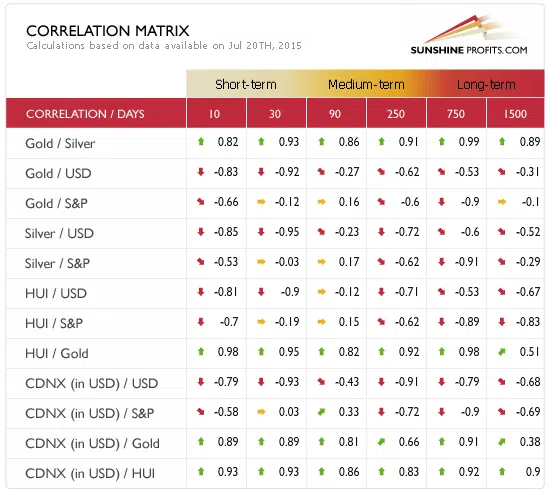Portfolio Diversifier
A portfolio diversifier is a portfolio addition which reduces the overall risk in a portfolio. This is an important feature, since diversification allows investor to obtain a desired return without taking as much risk as with an individual security.
Gold as Portfolio Diversifier
The yellow metal is considered to be a good diversifier. Why? The answer lies in the low or negative correlation with other assets. It is correlated neither to stocks nor bonds nor commodities (excluding silver; there is an occasional link with crude oil as you can read in our report on gold crude oil and silver).
The Correlation Matrix presented below, which is a very useful tool for gold, silver and gold stock correlation analysis, shows that gold is generally positively correlated with silver, negatively correlated with the U.S. dollar and not correlated with stocks (represented by the S&P index), although the precise strength of the correlation varies depending on the length of the time horizon.
Picture 1: Correlation Matrix (based on data available on July 20, 2015).

In addition, gold has no credit risk and has lower volatility than stocks or other commodities. Thanks to these features, gold can improve the risk-return characteristics of a financial portfolio. Because gold does not generally move together with other assets (there are different economic forces which determine the price of gold and other financial assets), it reduces the portfolio’s volatility.
To make it clear: including gold in a portfolio does not necessarily boost returns (however, according to the WGC, by investing 9 percent of a portfolio using high risk correlations in gold, investors would have reduced their losses by 13 percent). The aim is rather to reduce risk at a given level of expected profits (i.e. to increase risk-adjusted returns). Since gold is virtually uncorrelated with stock returns, it adds no systematic risk to an investor’s portfolio (so it shows the characteristics of a zero-beta asset, according to McCown and Zimmerman, 2006). Yet, gold has a positive risk premium, which makes it a very useful addition to an investor’s portfolio.
What is important is that the gold’s correlation with other assets is not stable, but changes during periods of financial distress in a way that benefits investors. While the correlation between bonds and stocks tends to increase during economic turmoil, gold usually becomes negatively correlated with other asset classes in such times. This means that the diversification benefits of gold are maintained and may even increase during severe crises.
It should be clear now that being a good diversifier and a safe haven (hedge) are two sides of the same coin. If gold was not a safe haven (hedge), there would be no point in holding it in a portfolio on average (in times of turmoil), and if gold was not a good diversifier in normal and critical times, it would not be a hedge and a safe haven.
To sum up, gold has low or negative correlations with other assets, so it is a good diversifier. Including the yellow metal in a portfolio may improve its efficiency in terms of higher reward-to-risk ratios. The optimal weight of gold in portfolio is subject to debate - you will find our take on the above in our gold portfolio report.
We encourage you to learn more about gold – not only why it is a portfolio diversifier, but also how to successfully use the shiny metal as an investment or portfolio diversifier and how to profitably trade it. A great way to start is to sign up for our gold newsletter today. It's free and if you don't like it, you can easily unsubscribe.